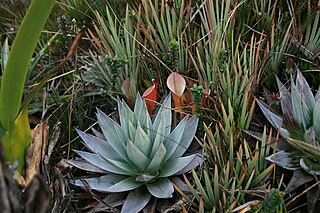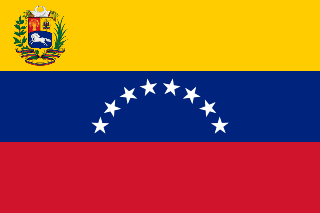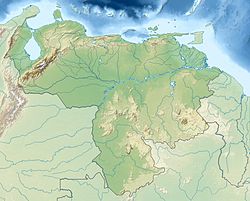
Auyán Tepui, also spelled Ayan, is a tepui in Bolívar state, Venezuela. It is the most visited and one of the largest tepuis in the Guiana Highlands, with a summit area of 666.9 km2 (257.5 sq mi) and an estimated slope area of 715 km2 (276 sq mi). The uneven, heart-shaped summit plateau of Auyán-tepui is heavily inclined, rising from around 1,600 metres (5,200 ft) in the northwest to a maximum of 2,450 m (8,040 ft) in the southeast. It is incised from the north by a vast valley, the Cañón del Diablo, formed by the Churún River. The larger western portion of the plateau is partially forested, whereas the eastern part comprises mostly bare rock with only patchy vegetation cover. The mountain hosts a number of extensive cave systems.

Cerro Marahuaca, also spelled Marahuaka, is a tepui in Amazonas state, Venezuela. It has an elevation of 2,832 metres (9,291 ft) above sea level and is the second-highest mountain of the entire Guayana Shield. Cerro Marahuaca shares a common base with the much larger Cerro Duida and together they form the Duida–Marahuaca Massif. Both tepuis are located entirely within the bounds of Duida–Marahuaca National Park.

Upuigma-tepui, also known as El Castillo, is a tepui in Bolívar state, Venezuela. A relatively isolated peak, both it and nearby Angasima-tepui lie just south of the vast Chimantá Massif, from which they are separated by the Río Aparurén valley. Upuigma-tepui is situated entirely within the bounds of Canaima National Park.

The natural range of the carnivorous plant genus Heliamphora is restricted to the southern Venezuelan states of Amazonas and Bolívar, and to adjacent portions of northern Brazil and western Guyana, an area corresponding to the western part of the Guayana Shield. These plants are largely confined to the summits and foothills of the sandstone table-top mountains of the region, known as tepuis.

Cerro Huachamacari, also spelled Huachamakari or Kushamakari, is a tepui in Amazonas state, Venezuela. It lies northwest of the giant Cerro Duida and the other peaks of the Duida–Marahuaca Massif, and is considerably lower at only around 1,900 metres (6,200 ft).

Aprada-tepui is a tepui in Bolívar state, Venezuela. It has an elevation of around 2,500 metres (8,200 ft) above sea level. It gives its name to the Aprada Massif, which also includes the smaller Araopán-tepui to the east. A steep, semi-circular ridge connects these two summits. Aprada-tepui lies 22 kilometres (14 mi) northwest of the much larger Chimantá Massif and around 25 km (16 mi) east of the Pemón village of Urimán.

Araopán-tepui is a tepui in Bolívar state, Venezuela. It has an elevation of around 2,450 metres (8,040 ft) above sea level. Together with the larger Aprada-tepui to the west, it forms part of the Aprada Massif. A steep, semi-circular ridge connects these two summits.

The Chimantá Massif is a highly fragmented complex of tepuis in Bolívar state, Venezuela. The massif comprises around 11 tepuis and has a total summit area of 615 km2 (237 sq mi) and an estimated slope area of 915 km2 (353 sq mi). It is divided in two by the Río Tírica, with the northern section being both larger and higher. The massif is notable for its high species richness and for its varied habitat types. It reaches an elevation of 2,698 metres (8,852 ft) on its highest peak, Murey-tepui. The massif is situated entirely within the bounds of Canaima National Park. It hosts extensive cave systems, including the world's largest known quartzite cave, Cueva Charles Brewer, named after discoverer Charles Brewer-Carías. The processes behind their speleogenesis are the subject of some debate.

Uei-tepui, also known as Wei-tepui, Cerro El Sol or Serra do Sol is a tepui on the border between Brazil and Venezuela. It may be considered the southernmost member of the Eastern Tepuis chain.

Kamarkawarai-tepui, also spelled Kamarkaiwaran or Camarcai-barai, is the easternmost and tallest of the four main tepuis of the Los Testigos chain in Bolívar, Venezuela. It is connected to the two nearest peaks of the massif—Murisipán-tepui and Tereke-yurén-tepui—by a common basement. The mostly bare summit plateau of Kamarkawarai-tepui has a large, collapsed sinkhole opening in its western portion.

Tereke-yurén-tepui is one of the four main tepuis of the Los Testigos chain in Bolívar, Venezuela. Looking west to east, it is the third major peak of the massif and is connected to Murisipán-tepui and Kamarkawarai-tepui by a common basement. With a summit area of 0.63 km2 (0.24 sq mi) and an elevation of around 1,900 metres (6,200 ft), Tereke-yurén-tepui is both the smallest and lowest of the four peaks. Its summit plateau comprises mostly bare rock.

Angasima-tepui, also known as Adanta, Adankasima or Adankachimö, is a tepui in Bolívar state, Venezuela. A relatively isolated peak, both it and nearby Upuigma-tepui lie just south of the vast Chimantá Massif, from which they are separated by the Río Aparurén valley. Amurí-tepui, the closest member of the Chimantá Massif, is only 8 kilometres (5.0 mi) from Angasima-tepui.

The Eastern Tepuis, also known as the Roraima–Ilú range, is a mountain chain stretching for some 60 kilometres (37 mi) along the border between the disputed territory of Guayana Esequiba in Guyana, Venezuela and, to a small extent, Brazil. It runs in a northwesterly direction from the tripoint of these countries, closely following the Guyana–Venezuela border, with a single major peak (Uei-tepui) to the south, on the Brazil–Venezuela border. Moving northwest from Uei-tepui (2,150 m), the main summits of this chain are Roraima-tepui (2,810 m), Kukenán-tepui (2,650 m), Yuruaní-tepui (2,400 m), Wadakapiapué-tepui (2,000 m), Karaurín-tepui (2,500 ), Ilú-tepui (2,700 m), and Tramen-tepui. The minor peak of Wei-Assipu-tepui lies entirely outside Venezuela, on the border between Brazil and Guyana. Additionally, there are a number of minor plateaus which form a chain between Uei-tepui and Roraima-tepui. Ilú- and Tramen-tepuis are often treated together since they are joined by a common base.

Uaipán-tepui, also spelled Waipán, is a tepui in Bolívar state, Venezuela. It is a southern satellite peak of the vast Auyán Massif, with a maximum elevation of around 1,950 metres (6,400 ft). Its mostly forested summit plateau has an area of 2.5 km2 (0.97 sq mi). The mountain's slope area has been estimated at 60 km2 (23 sq mi).

Ptari-tepui, also spelled Pu-tari and sometimes called Cerro Budare or Cerro del Budare, is a tepui in Bolívar state, Venezuela. Lying near the centre of the Sierra de Lema, it has a maximum elevation of around 2,400 metres (7,900 ft) above sea level. Its mostly bare summit plateau has an area of 1.25 km2 (0.48 sq mi). Though generally flat, distinctive erosional rock formations are found on the more dissected eastern edge of the summit.

Carrao-tepui, also spelled Karrao, is a tepui in Bolívar state, Venezuela. It has a maximum elevation of around 2,200 metres (7,200 ft) and its densely forested summit plateau covers an area of 1.25 km2 (0.48 sq mi). Part of the Ptari Massif, it lies just northeast of neighbouring Ptari-tepui, with which it shares a common slope area of 28 km2 (11 sq mi), and north of the large ridge known as Sororopán-tepui.

Cerro Aracamuni is a tepui in Amazonas state, Venezuela. Part of the Neblina–Aracamuni Massif, it lies north of Cerro Avispa and the vast complex of Cerro de la Neblina. Cerro Aracamuni and Cerro Avispa share a common slope area; they have a combined summit area of 238 km2 (92 sq mi) and an estimated combined slope area of 658 km2 (254 sq mi). Both of these cerro-plateaus have a maximum elevation of around 1,600 metres (5,200 ft).

Cerro Avispa is a tepui in Amazonas state, Venezuela. Part of the Neblina–Aracamuni Massif, it lies south of Cerro Aracamuni and north of Cerro de la Neblina. Cerro Avispa and Cerro Aracamuni have a combined summit area of 238 km2 (92 sq mi) and an estimated combined slope area of 658 km2 (254 sq mi). Both of these cerro-plateaus have a maximum elevation of around 1,600 metres (5,200 ft).











